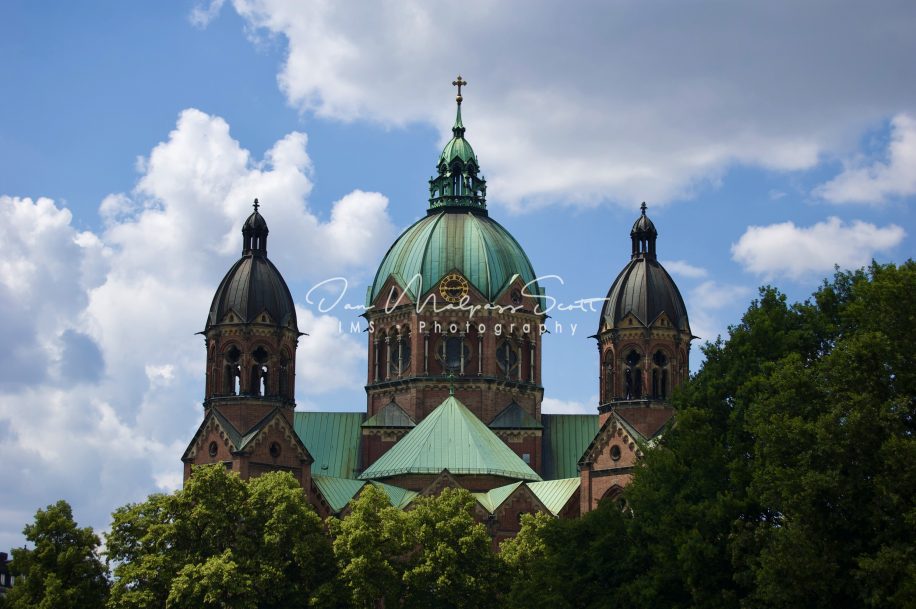![]()
St. Luke, Munich, Germany.
The Evangelical-Lutheran parish church of St. Luke, also known as the Lukaskirche, was the third Evangelical-Lutheran church to be built in Munich. After the first two evangelical churches were named after the evangelists Matthew and Mark, they were given the name of the evangelist Luke, continuing this tradition.
The steady increase in church members quickly made the two existing Evangelical Lutheran parish churches of St. Matthew and St. Mark too small. As early as 1893, Protestant services were held at three other locations in Haidhausen, Schwabing and Neuhausen. In this respect, a third Protestant church building was unavoidable. The Lukaskirche was built in 1893-1896 according to plans by Albert Schmidt. St. Lukas is the only almost completely preserved Protestant church of historicism in Munich. It is also known as the “Protestant Cathedral” because of its towering crossing dome, the two flanking towers and its overwhelming interior.
The northern tip of the Kohleninsel, today’s Museum Island, was intended as the building site. A modest church was to be built there. Since the Bavarian ruling family was concerned about the clear Catholic dominance in Munich, other Christian denominations were only given building sites that could not shape the cityscape; the only exception to this principle was the church of St. Matthew, which was demolished in 1938.
The Evangelical Lutheran Church Building Authority was not satisfied with this. It was able to convince both Prince Regent Luitpold and the government of Upper Bavaria that Schmidt’s design, favored by the Prince Regent and the government of Upper Bavaria, required a larger building site than that on the Kohleninsel. At the same time, the church building authority argued that a simpler building would suffice for the purposes of the evangelical congregation and that the costs for the evangelical-lutheran congregation in Munich were too high; So the royal capital and residence city of Munich supported the construction by providing a generous plot of land on Mariannenplatz in Lehel.
On June 29, 1893, the foundation stone for St. Luke was laid, and the inauguration took place on the first Sunday of Advent 1896 (November 29). The financing of the construction came about essentially through donations and grants from the church levy, roughly comparable to today’s church fees. Luitpold von Bayern donated the glasses of the southern and northern rose windows. They represented the birth and ascension of Christ. The prince regent was particularly pleased with the beautiful Steinmayer organ on the occasion of the presentation of the stained glass windows, at which cantor Johann Engelhardt played an Advent chorale.
St. Luke was not elevated to the status of a parish church until 1900, when an independent parish was founded. The church survived the bombing raids of the Second World War almost undamaged, and in contrast to the parsonage that belonged to it, it also survived the modernization and purification waves of the 1960s and 1970s. However, the stained glass windows from the workshops of the Mayer’schen Hofkunstschule fell victim to the air raid on the night of September 6th and 7th, 1943. In order to preserve the original, deliberately mystical impression of the room, the colored glazing, which is so important for this, was restored immediately after the end of the war.
From 1945 through the 1950s, the church was used for services by members of the US occupation forces.
Although the Hague Convention included it in the list of cultural assets worthy of protection in 1976, the church was never completely renovated. On October 11, 1998, at around 10:30 p.m., a stone fell out of the southern window rosette and fell right next to the children’s playground on Mariannenplatz. Since then St. Lukas has been considered dilapidated and partly in danger of collapsing. The building renovation was originally supposed to be completed in 2006, but has been delayed for various reasons. The start of the renovation work has now been announced for 2024.


